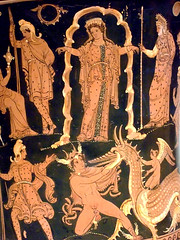 King Herod may have been buried in a crypt with lavish Roman-style wall paintings of a kind previously unseen in the Middle East, Israeli archaeologists said Wednesday. The scientists found such paintings and signs of a regal two-story mausoleum, bolstering their conviction that the ancient Jewish monarch was buried there.
King Herod may have been buried in a crypt with lavish Roman-style wall paintings of a kind previously unseen in the Middle East, Israeli archaeologists said Wednesday. The scientists found such paintings and signs of a regal two-story mausoleum, bolstering their conviction that the ancient Jewish monarch was buried there. Ehud Netzer, head of Jerusalem's Hebrew University excavation team, which uncovered the site of the king's winter palace in the Judean desert in 2007, said the latest finds show work and funding fit for a king.
"What we found here, spread all around, are architectural fragments that enable us to restore a monument of 25 meters high, 75 feet high, very elegant, which fits Herod's taste and status," he told The Associated Press in an interview at the hillside dig in an Israeli-controlled part of the West Bank, south of Jerusalem.
No human remains or inscriptions have been found to prove conclusively that the tomb was Herod's, but excavation continues.
Herod is known for extensive building throughout the Holy Land.
Netzer said that since finding fragments of one ornately carved sarcophagus in 2007, he and his team have found two more, suggesting the monumental tomb may have been a royal family vault. Netzer described the winter palace, built on a largely man-made hill 2,230 feet high, as a kind of "country club," with a pool, baths, gardens fed by pools and aqueducts and a 650-seat theater. In Herod's private box at the auditorium, diggers discovered delicate frescoes depicting windows opening on to painted landscapes, one of which shows what appears to be a southern Italian farm, said Roi Porat, one of Netzer's assistants on the digs. Just visible in the paintings, dating between 15 and 10 B.C., are a dog, bushes and what looks like a country villa. Site surveyor Rachel Chachy-Laureys said the paintings were executed using techniques unknown in the Holy Land at the time and must have been done by artisans imported from Rome. "There has been no other discovery of this type of painting in the Middle East, as far as we know, until now", she said. After Herod's death in the 1st century B.C., Herodium became a stronghold for Jewish rebels fighting Roman occupation, and the palace site suffered significant battle damage before it was destroyed by Roman soldiers in A.D. 71, a year after they razed the Second Temple in Jerusalem. The insurgents reviled the memory of Herod as a Roman puppet, and Netzer and his team believe that the violence inflicted on the first stone casket they found suggests the rebels knew it held the king's bones. "That sarcophagus was found shattered all over the place. It seems it was taken from its place and was destroyed in a fit of rage," Porat said. "That, among other things, is what tells us it was the sarcophagus of Herod."



